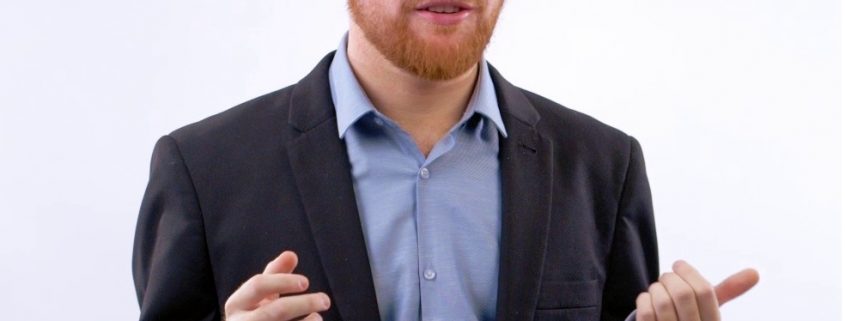“Virus, the Beauty of the Beast” – an Interview with Hamish Todd
If you haven’t seen Virus, the Beauty of the Beast, I suggest you stop what you’re doing right now: grab a cup of tea with one hand and your mouse with the other and sit down to enjoy Hamish Todd’s latest creation that has been 3 years in the making. It’s an interactive documentary combining viruses, mathematics and architecture and is a stunning example of science communication done right.

Hamish’s documentary combines video and gameplay to make for a perfectly paced and interactive piece. One can learn about viruses, their connections to human architectural structures and the mathematical principles behind it by viewing and manipulating 3D models of the viruses, and flipping between their 2D and 3D shapes.
Hi Hamish, what inspired you to create “Virus, the Beauty of the Beast”?
Long story short, a woman called Reidun Twarock! She’s a professor at the mathematics department at the University of York, where I did my bachelor’s. She is a virologist dealing with mathematics that is as sophisticated and beautiful as the mathematics you will find anywhere. I had never studied molecular biology before, so her course, with its incredible applications, was staggering to me; it’s also where I found out about the Islamic art connection. Her research sort of appears in the chapter on Zika virus.
It’s a project that has been 3 years in the making, what does the process of building a project of such magnitude look like?
For the most part, it’s horrible! There’s a famous principle I learned when I was in the games industry: “The first 90 percent of the content accounts for the first 90 percent of the development time. The remaining 10 percent of the content accounts for the other 90 percent of the development time”.
This is extremely true! After about 18 months, I did have something to show, and a friend of mine said he would just have published it. But I knew that wouldn’t be doing justice to the material, so I kept at it by saying “three more months, three more months” – my friends and family got sick of hearing me say that! All the way back then, it did feel kinda cool and I did think about publishing it then and there, but looking back, version 1.0 was awful… so there’s satisfaction in having improved it… but apart from the delivery (I saw a voice coach at the 2 year point!) all the changes feel minor, rather than big important philosophical things.
What was the most challenging part of creating this documentary?
Definitely figuring out how to combine the interaction and video in a way that is entertaining – it’s harder than it looks! The technical side is easy. The difficult part is making it so you’re intrigued enough to want to play around, but informed enough to know what to do. To give an example, I say things like “use this button” instead of “this button will open and close the virus”, because that would “spoil” a surprise for the audience. I have a whole lecture on how it fits into my design philosophy.
And the most rewarding?
Figuring out the origami connection felt great, and I love the way the zika model turned out… but something very rewarding happened yesterday – a woman I’ve never met from Nigeria said to me, on twitter, “god bless the illustrators and scientists making things easier for visual learners!”. I guess people in Nigeria say “god bless you” more often than people in Britain, but, well, that just made me feel great.
Which is your favourite virus of them all?
Human Papillomavirus! Apologies to those who have suffered because of it, but that’s such an easy question for me 🙂 The history is this: the hexagons-and-pentagons model was developed pretty much as soon as we were getting pictures of viruses. Lots of data was coming in, and it all fit the model. Then you get HPV (or to be more specific, a related virus called polyomavirus), and it looked for all the world like another virus like that, but they stared at the “hexagons” and realized they were made of five proteins, not six. “Five not six” sounds mundane, I know… but that is the root of the connection to the Islamic art connection – and it was the first clue that led Reidun Twarock to create virus models based on six-dimensional patterns! In tribute, the first picture of HPV appears in the documentary.
This isn’t the first interactive piece you’ve created, what else have you made?
I created this puzzle game, also in large part inspired by Islamic art! This is another interactive documentary I made, about Measles epidemiology; this is about the Hepatitis B vaccine developed here in Edinburgh (it takes a while to load), and this is about a mathematical field called topology. That last one was made in one week – you’ll see big differences in quality! That’s why some projects take years!
What’s next in the works?
I need to focus on my PhD really! But there’s a clear problem with the format of Virus, the Beauty of the Beast, which is that the separation of the video and the “stuff” is inelegant. My next thing will be a cross between “Virus, the Beauty of the Beast” and this project!
Thank you so much Hamish! If you enjoyed his work and want to support him in making future creations, you can pledge to him on Patreon. He didn’t ask us by the way – we just love his work that much!
Follow Hamish on:
Twitter: @hamish_todd
Facebook: Virus Patterns
Interview conducted by Inés Dawson





Leave a Reply
Want to join the discussion?Feel free to contribute!